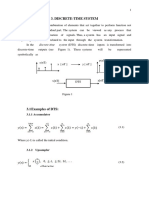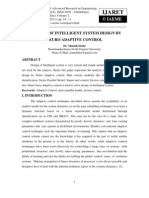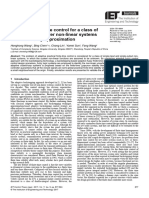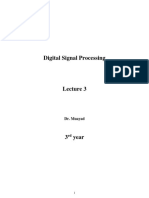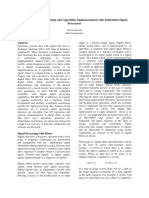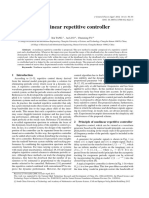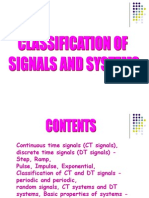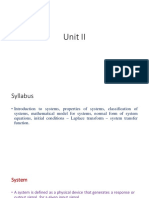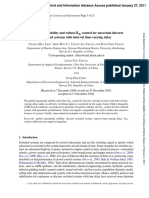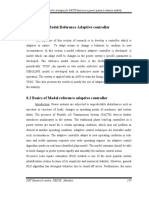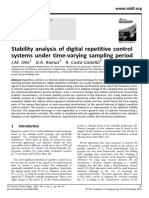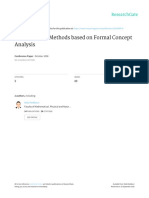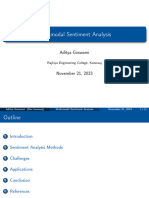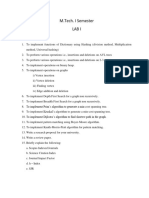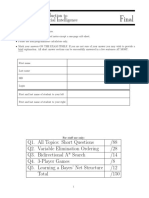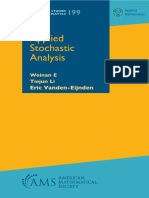Analysis of Linear Time Invariant Systems With Time Delay
Uploaded by
Thái Minh NhậtAnalysis of Linear Time Invariant Systems With Time Delay
Uploaded by
Thái Minh NhậtAnalysis of Linear Time Invariant
Systems With Time Delay
Time Delay Control has recently been suggested as an alternative scheme for control
of systems with unknown dynamics and unpredictable disturbances. The proposed
control algorithm does not require an explicit plant model nor does it depend on
the estimation of specific plant parameters. Rather, it uses information in the recent
past to directly estimate the unknown dynamics at any given instant, through time
delay. In earlier papers, analysis and implementation of Time Delay Controller for
K. Youcef-Toumi nonlinear systems were discussed. This paper analyzes the continuous Time Delay
Associate Professor. Controller for a class of linear systems and presents necessary and sufficient con-
ditions for control system stability. A necessary condition for stability is derived
using the properties of linear time-delayed systems. This condition involves only a
S. Reddy few of the system and controller parameters and facilitates design of the Time Delay
Graduate Student. Controller. It is proved that this necessary condition is also sufficient if the delay
time is chosen to be infinitesimally small. The convergence of closed loop system
Department of Mechanical Engineering, error to zero for certain classes of inputs and disturbances when the system is stable
Massachusetts Institute of Technology, is also established. It is also shown that certain approximations in the control
Cambridge, MA 02139 algorithm and certain additional unmodeled dynamics render the closed loop system
under continuous Time Delay Control to be not exponentially stable due to the
controller poles on the imaginary axis at infinitely high frequencies. However, in
digital implementation, all the signals are prefiltered by anti-aliasing filters prior to
sampling. Hence, the highest frequency component is automatically limited and the
issue of exponential instability is not encountered. A discussion is presented com-
paring Time Delay Control with Repetitive Control. It is indicated that the Time
Delay Controller can perform the functions of a repetitive controller with the delay
time replaced by the period of the reference input while the repetitive controller can
perform the functions of Time Delay Controller for sufficiently small "period" for
a certain class of linear systems. Furthermore, examples are included to illustrate
the results.
1 Introduction
Some classical control methods deal with well known linear Systems which are capable of recognizing the familiar fea-
time-invariant systems. In many applications, however, some tures and patterns of a situation and which use past experiences
relevant part of the system may be unknown, time varying, or in behaving in an optimal fashion are called Learning Systems.
nonlinear. Controlled systems are thus often limited to op- A learning system, when presented with a novel situation,
erating in only a small portion of their available range. Re- learns how to behave by an adaptive approach. Then if the
strictions such as these have led to the development of control system experiences the same situation, it will recognize and
techniques that deal with such complexities. behave optimally without going through the same adaptive
Several modern control strategies have been developed for approach. An advantage is that the system need not be iden-
uncertain linear and nonlinear systems. Adaptive control [2, tified in every environmental situation, making the response
6, 12, 16] requires parameterization of system model in terms time faster under situations that have already been learned. A
of unknown parameters which in turn are estimated by an drawback is that such systems often require repetitive trial and
adaptive algorithm. Sliding Mode Control [15] uses a switching error to bring them into an operating state [1, 19].
technique to force the system to converge to the desired tra- Repetitive control is a controller that uses internal model
jectories. Other techniques include learning control and re- principle in controller design to ensure convergence of the
petitive control. system output to a periodic reference input or stay unperturbed
in the face of periodic disturbances, given the period of the
Contributed by the Dynamic Systems and Control Division for publication reference input or disturbance. This was originally studied in
in the JOURNAL OF DYNAMIC SYSTEMS, MEASUREMENT, AND CONTROL. Manuscript continuous domain [9] but has been studied in discrete domain
received by the Dynamic Systems and Control Division September 17, 1991; in detail [5, 17, 18], for linear systems. Systems with strictly
revised manuscript received January 28, 1992. Associate Technical Editor:
A. G. Ulsoy. proper plants under continuous repetitive control can not be
544/Vol. 114, DECEMBER 1992 Transactions of the ASME
Copyright © 1992 by ASME
Downloaded From: http://dynamicsystems.asmedigitalcollection.asme.org/ on 01/27/2016 Terms of Use: http://www.asme.org/about-asme/terms-of-use
exponentially stable, as established in [9]. However, for digital trol to be not exponentially stable due to the infinite number
repetitive control, this problem does not arise due to the limit of controller poles on the imaginary axis. However, in digital
placed on the highest frequency component [17, 18]. The re- implementation of the Time Delay Controller, the stability
petitive control can be modified with the insertion of a filter problem is reduced to the stability analysis of the associated
to provide or improve stability in both cases at the expense of discrete system. This discrete system is finite-dimensional and
convergence [5]. Repetitive control has also been studied for hence the issue of exponential instability is not encountered.
certain nonlinear systems such as robot manipulators [14]. The A discussion is presented comparing Time Delay Control with
requirement that the inputs or disturbances be periodic and Repetitive Control. It is indicated that the Time Delay Con-
the period be exactly known could prove to be very restrictive. troller can perform the functions of a repetitive controller with
However, the repetitive controller and the Time Delay Con- the delay time replaced by the period of the reference input
troller have certain structural similarities and a comparison while the repetitive controller can perform the functions of
between the two is initiated in this paper. Time Delay Controller for sufficiently small "period" for a
Time Delay Control (TDC) proposed in references [23-26, certain class of linear systems. Finally examples are included
30-32], does not depend on estimation of specific parameters, to demonstrate the results.
repetitive actions, infinite switching frequencies, or discontin- The notation used is as follows: <RP represents the set of p-
uous control. It does not presume linearity. It employs, rather, dimensional vectors Si"*" represents the set of (pxq) ma-
direct estimation of the effect of the plant dynamics through trices, lp represents thep xp identity matrix and 0 p x ? represents
the use of time delay. The controller uses the gathered infor- the (pxq) zero matrix. IIMII is an induced norm of matrix
mation to cancel the unknown dynamics and disturbances si- M.
multaneously and then inserts the desired dynamics into the
plant. The TDC employs past observation of the system re-
sponse and control inputs to directly modify the control actions 2 Time Delay Control Law
rather than adjust the controller gains. It updates its obser- In this paper, we are concerned with a class of systems
vation of the system every sampling period, therefore, esti- described by the following linear time invariant differential
mation of the plant dynamics is dependent upon the sampling equations,
frequency.
The TDC has a similar feature as the learning control al- x(t)=Ax(t)+Px(t)+Bn(t)+Ji(t) (1)
gorithm proposed in reference [10]. This learning control al- where x(t)£6i" and u(/)€(Rr are the system state vector and
gorithm is applicable for nonlinear systems with linear input control input vector, respectively. A, P, B are constant system
action. It updates the control action in each learning trial by matrices with appropriate dimensions. D(f) represent a dis-
comparing the state derivative of the actual trajectory with turbance vector and the variable t represents time. The state
that of the desired reference trajectory in the previous trial. vector x, the system matrices and the disturbance are parti-
Time Delay Control differs from this approach in that the tioned as follows,
control action is updated at each instant based on recent past.
The TDC control algorithm leads to systems that have a
similar form to that of time delay systems. These systems,
which are also referred to as time-lag or retarded systems, are
systems in which time delay exists between the cause and effect. where the partial states are x„€(R" r, xre(Rr and,
In time delay systems, these delays arise as a result of delays 0 " 0
existing in the hardware components or computation [3]. The I„
, p= )
mathematical formulation for such time delay systems leads _ Pr'_
to delayed differential equations. A special class of these equa-
tions are referred to as integral-differential equations which 0 0
B! = D(0 =
were studied by Volterra [21], Volterra was the first to study D/CO.
such systems and developed the theory to investigate the con-
sequences of time delay. Several other researchers have con- where the matrix Ar€(R " is known and the matrices Pr6(R''x",
rx
tributed to the development of the general theory of the Volterra Br€<Rrxr are not exactly known and Dr(/)€(Rr is an unknown
type. Reference [13] provides several references of contributors disturbance vector. However, it is assumed that Br is nonsin-
to delayed differential equations including historical perspec- gular. The objective is to design a controller that makes the
tive of control theory and developments of time delay. above system follow a reference model accurately despite the
The Time Delay Control was originally formulated in [23] presence of unknown dynamics and large unexpected disturb-
for a class of nonlinear systems with linear input action. The ances. A reference model which generates a desired trajectory
control algorithm has been applied to robot manipulators, is chosen as an asymptotically stable linear time invariant sys-
servo systems and magnetic bearings with very satisfactory tem of the form,
results even under large system parameter variations and dis- (t)+Bmr(t) (2)
turbances [23-26, 28, 31]. Stability and convergence analysis
was performed for linear SISO systems with approximations where xm(t)€(R" is a reference model state vector and r(t)£(Rr
for the delay in [27]. In reference [30], sufficient conditions is a reference input. Am and B„, are constant matrices with
for stability were derived for linear uncertain SISO systems appropriate dimensions and selected such that xm (t) has certain
using Nyquist criterion and Kharitonov theorem. Sufficient desirable dynamics. The matrix Am is nonsingular and has all
conditions for bounded-input bounded-output stability are de- its eigenvalues in open Left-Half-Plane so that the reference
rived for a class of nonlinear systems in [31], model is asymptotically stable. The reference model matrices
This paper outlines the Time Delay Control law for a class are also partitioned in a similar way as the system matrices,
of linear time invariant systems. Necessary and sufficient con-
ditions for continuous TDC control system stability for this 0 ; W 0
class of systems are presented. Then it is proved that the con- A„,= . Bra
vergence of the stable system error to zero for certain inputs
and disturbances is assured. It is shown that certain approx-
imations in differentiation and certain additional unmodeled B^edT^, Bme(R"xr and r(t)€<Rr. Systems
dynamics render the system under continuous Time Delay Con- expressed in such special canonical form have been shown to
Journal of Dynamic Systems, Measurement, and Control DECEMBER 1992, Vol. 114 / 545
Downloaded From: http://dynamicsystems.asmedigitalcollection.asme.org/ on 01/27/2016 Terms of Use: http://www.asme.org/about-asme/terms-of-use
satisfy a well known matching condition [23, 25, 26]. This
paper will only consider systems which belong to this class.
The error e(t) between the desired trajectory xm(t) and the
Pr(x(t)-x(t-L))+Br(t)-Dr(t-L)+(Br-Br)(u{t)
actual trajectory x(t) is defined as
-u(t-L)) + Amrx(t) +B,„,r(/) -Kre(t)
e(0=xm(0-x(0 (3)
The objective is to generate the control action that forces the (9)
error to vanish according to the following dynamic equations,
where xseffl("~r> is the vector of last {n-r) elements of the
e=(A,„ + K)e = A,,e (4) state vector x. The error e defined in Eq. (3) is then governed
where the matrix K€(R"X" is. a feedback matrix of the form, by
0 e ( 0 = (A,„ + K)e(0
K=
Kr
0
rx
with Kr€<R ". The matrix (Am + K) must have all its eigen-
(Pr(x(t~L)-x(t))+Qr(t-L)-Dr(t) (10)
values in the Left-Half Plane so that the desired error dynamics
are asymptotically stable. It is seen from Eqs. (1), (2), and (4) + (Br-Br)(u(t-L)-u(t))
that the required control action u(/) is given by
Bru(t)=-Arx(t)-Prx(t)-Dr(t) The difference between the actual error dynamics given by Eq.
+ Amrx(t)+Bmrr(t)-Kre(t) (5) (10) and the desired error dynamics given by Eq. (4) is due to
the approximation in estimating unknown dynamics and dis-
However, P r , T>r(t) and B r are not known. B r , a matrix selected turbances using time delay L, and the difference between the
by the designer is used as an estimate of the unknown B r . In estimate B r and B r . For L = 0, the actual error dynamics of
the version of Time Delay Control algorithm presented in this Eq. (10) are the same as the desired error dynamics of Eq. (4).
paper, the estimation scheme used for estimating unknown The Time Delay Control law uses information in the recent
function Prx(t) +jyr(t) involves approximating its value at past to directly estimate the unknown dynamics at any given
instant t by that evaluated an instant in the recent past, (t-L), instant. It has been shown to provide excellent control per-
where L is the time delay. In other words, formance, through several successful simulations and experi-
H(/)=H(f-L) ments . In this paper we will focus on the special class of systems
(6)
defined above and investigate the stability and convergence
where properties of the closed-loop control system.
H(0=Prx(/)+Dr(t)
The intuitive logic used is that the value of the unknown dy- 3 Stability Analysis
namic function H(t) does not vary significantly over the in- The control law described in the previous section results in
terval L if it is chosen to be "sufficiently small." Using Eq. a closed-loop system that is linear time-invariant. Hence the
(1) and noting that a nonsingular matrix Br is used for the stability of the closed-loop system can be analyzed using linear
unknown B r , the estimate of unknown function H(t), H ( 0 systems theory. In this section, we present results pertaining
is given by to the stability of control systems described in the previous
H(t) = xr(t-L)-Arx(t-L)-Bru(t-L) (7) section. First, a necessary and sufficient condition for stability
is derived. Then a necessary condition for stability involving
It is assumed that exact value of x r (t — L) is available at instant fewer system and controller parameters is presented. It is shown
t. The delay L is used to enable causal estimation of the un- that this necessary condition is also a sufficient one for the
known function. This estimation scheme is equally applicable case of L —0.
to nonlinear systems [23, 25, 26].
Replacing the terms P r x ( / ) + D r ( / ) a n d B r i n E q . (5) by their 3.1 Necessary and Sufficient Condition for Stability. Nec-
estimates U.(t) (given by Eq. (7)), and Br respectively, the essary and sufficient condition for stability of linear time in-
following Time Delay Control law is obtained. variant systems under Time Delay Control is summarized in
the following theorem.
u(t)=u(t-L)+B;1[-xr{t-L)+Arx{t-L)
Theorem 1. The closed-loop system under continuous Time
-Arx(t)+Amrx(t) +Bmrr(0-K,e(OJ (8) Delay Control with L^O is exponentially stable if and only if
In the above control law, the choice of L is limited by noise the eigenvalues X of the following characteristic Eq. (11) lie
sensitivity considerations, though it is desirable that it be suf- in the open Left-Half-Plane,
ficiently small. In a digital implementation, L is also limited
by computational and sampling considerations. It is assumed \[i„_ r ; o ] - [ o ;i f l _ r i
that measurements or estimates of all states are available. The
det (^ ')([0 : I r ]X-(A r + P r ) ) - B r B r - ' ( - [ 0 \ I,]X
delayed state derivative term xr(t-L) may be estimated from
the measurements of states. This can be avoided by use of an LX
+ A,(1 e )+(Amr + Kr)e }
LX
estimation scheme involving convolutions [29]. The control
law of Eq. (8) is used for the analysis in this paper. Substituting
(11)
the above control law in Eq. (1),
x(t) Proof: Taking the Laplace transform of the expression for
u ( 0 of Eq. (8) leads to,
\](s)(\-e-Ls)=B;l[-se-Ls\r(s)
Arx(t)+Prx{t)+(Br-Br)u(t)+Dr(t)+[Bru(t-L) + e-L%(0) + K(e~Ls-l)X(s)
- xr(t-L)+Arx(t-L) -Arx(t) +Amrx(t) + (Amr + Kr)X(s)+BmrR(s)-KrXm(s)]
+ Bmrr(t)-Kre(t)] This equation is now rewritten as,
546/Vol. 114, DECEMBER 1992 Transactions of the ASME
Downloaded From: http://dynamicsystems.asmedigitalcollection.asme.org/ on 01/27/2016 Terms of Use: http://www.asme.org/about-asme/terms-of-use
B to perform a stability search over a range of Pr and B n par-
V(s)=-^-~[~sXr(s)+xM + AAl-eLs)X(s) ticularly for multi-input multi-output systems. However, for
SISO systems, a modified form of Kharitonov Theorem can
+ (Amr + Kr)eLsX(s) + B m ^ s R ( s ) -K^Xm(s)] (12) be used for performing robust stability analysis [30]. For MIMO
Taking the Laplace transform of the state Eqs. (1) results in systems, if a rational transfer function approximation is used
in place of e"Ls, Kharitonov theorem can be employed to
[sIn-(A + P)]X(s)=EU(s)+D(s)+x(0) perform a search for stability over a range of Pr and B r to an
Substituting for V(s) and rearranging leads to, extent. The study of the error dynamic equations indicates that
for L-~0, the.actual error dynamics approach the desired error
BB"
s I „ - ( A + P)- s[Q : IJ + A X l - e ^ ) dynamics. It can be inferred that by choosing L to be "suf-
(e^-l) ficiently small," the stability dependence on unknown P r can
be substantially reduced. This is implied by Theorem 3 in
L
+ {Amr + Kr)e X(J) Section 3.3.
The stability result of Theorem 1 alone is not a satisfactory
' ' [BmrR (s) - KrXm (s)]eLs + xr(0) J + D (s) + x(0) tool in designing the Time Delay Control law since it involves
a number of unknown parameters. To facilitate the design
Partitioning the equations, process, the following result is derived. It provides a necessary
condition for stability which is dependent on fewer parameters.
~Sl„-r '• This provides a guideline in controller design.
BrBr 3.2 Instability Theorem. A necessary condition for sta-
[ o ; ir]s- [0 i lr]S bility (or conversely, sufficient condition for instability) is sum-
marized in the following theorem.
+ A r ( l - e i s ) + (A mr + K r )e ii )
Theorem 2. If there exists any solution for z of the equation
det[zI r + B r B r - ' - I r ] = 0
W such that \z\ >1, i.e., z lies outside the unit circle, then the
X(5) closed-loop system under continuous Time Delay Control is
(Ar + Pr) unstable.
x„-,(0) Proof: The proof of this theorem is based on the use of
Lemma 7.1 in Chapter 1 of reference [8] which deals with the
analysis of neutral differential difference equations. The
- ^ — ( [ B m r R ( i ) - K r X f f l ( s ) ] e i i + x r (0))+D r (5)+x r (0) Lemma is restated in Appendix A of this paper and is adapted
to the problem discussed here. This Lemma allows one to study
(13) the roots of a simpler equation to which the roots of the original
equation converge. Therefore, if there exists a root of the
Multiplying the last r equations by ( e ^ - l ) throughout, we simpler equation that lies in the open RHP, then the system
obtain governed by the original characteristic equation is unstable.
s[l„-r i 0 ] - [ 0 : I„„ r ]
X(s)
( e ^ - D J I O i I r ] 5 - ( A r + P r ) ) - B r f i r ' | - [ 0 i Ir]s + Ar(l-eLs) + (Amr + Kr)eu
x„-,(0)
(14)
B r Br'i[B mr R(5) - K r X m ( 5 ) ] / s + xr(0)) + (e^- l)(Dr(s) + xr(0))
The system is exponentially stable if the eigenvalues X of the
following characteristic equation lie in the open LHP. The
system is unstable if any X lies in the open RHP [22].
x[i„_ r ; o]-[o ; I „ _ J
det 0 (15)
( ^ x - 1){[0 : I r ]X-(A r + Pr)) - B A r ' Y - [0 f WX + (Ar(l - e ^ ) + ( A ^ + IQe^
This completes the proof. The determinant can be computed In order to use this procedure, we consider the Eq. (11) and
numerically at each frequency and the Nyquist plot be plotted establish the following statements,
and the stability analysis can be performed graphically. Various (i) A real number a exists such that Re(X)<a.
simulation packages such as MATLAB can be used for this
purpose. Since the stability condition derived involves un- Proof: Assume that this is not the case. Then there exists
known Pr and B r , it does not provide stability robustness in- a X satisfying Eq. (11) such that Re(X)~oo.
formation. It is not practical to use the above result directly If X ^ 0 and Re(X)^ - oo, then Eq. (11) is equivalent to:
[0 j 1,,-A
[i„-f;o]-
det =0
(A + P ) A
(i-e~LX- )^ ) r «[o:: i¥r], _ v £r v ^ r^ B f f l - . } _ [ 0 : ir]c-^ + ^ ; -1) + (A„, ; + K r )
Journal of Dynamic Systems, Measurement, and Control DECEMBER 1992, Vol. 114 / 547
Downloaded From: http://dynamicsystems.asmedigitalcollection.asme.org/ on 01/27/2016 Terms of Use: http://www.asme.org/about-asme/terms-of-use
Now if Re(X)—oo, the left-hand side of the above equation that the system can only be marginally stable. Therefore I z I < 1
reduces to for all solutions of (18), if the system is asymptotically stable.
(ii) If Br is singular, z = 1 is a solution of Eq. (18). However,
det = 1*0 Izl must be less than 1 for asymptotic stability. Therefore, B r
0 must be nonsingular.
Theorem 2 and Corollary 1 provide a limit on the choice of
and therefore, a contradiction. This implies that there exists the designer selected matrix B r with respect to the system gain
a real number a such that Re(X)<a. matrix Br. This limit is independent of other system and con-
(ii) If there exists any solution for X of the equation troller parameters such as L, An P r , Amr and Kr. With a knowl-
det[eLXIr + B r B 7 ' - I r ] = 0 edge of bounds on B r within which it is expected to lie, this
theorem can be used to check whether a selected B r satisfies
such that Re(X)>0, i.e., X lies in the Right Half Plane, then
the necessary condition for stability, as a preliminary step in
the closed-loop system under Time Delay Control is unstable.
controller design.
Proof: If X*0, Eq. (11) is equivalent to It should be emphasized that this necessary condition must
IO | ln-A
[In-r] Ol-
det =0 (16)
(^-DJtOiW-^r^l-B^'j-IO X X j
Since Re(X) < a and L > 0, I eLX I is bounded for all solutions be satisfied irrespective of how infinitesimally small L is. Ear-
X of the characteristic equation given by Eq. (11). Then as lier, in Section 2, we remarked that for L = 0, the actual error
IXI —oo, Eq. (16) reduces to dynamics of Eq. (10) are the same as the desired error dynamics
of Eq. (4). However, this does not imply that stability can
'ln-r 0 automatically be assured by choosing L to be infinitesimally
det =0
o A+BA'-l small. The choice of B r must satisfy the necessary condition
implied by Theorem 2 for all L * 0 . Once this is assured, L
which is equivalent to
can be chosen "sufficiently small" for robust stability. The
det(e LX I r + B r B r _1 - If) = 0 question that can now be posed is: if the necessary condition
Therefore, if there is a sequence (X,) of solutions of charac- implied by Theorem 2 is satisfied, is stability ensured for L—0,
teristic equation given by Eq. (11) such that I Xy I — oo as y— oo, i.e., by choosing L to be infinitesimally small? The answer is
then there is a sequence (X/ j of zeros of Eq. (17) such that yes and is restated below as a theorem.
X/-X/--0 as y-~oo. It can be shown that there always exists
3.3 Conditions for Stability f o r i —0. Theorem 3. The
such a sequence (Xyj [8]. Considering the determinant stated
closed-loop system under continuous Time Delay Control is
above and letting z = e^x would result in an algebraic equation
asymptotically stable for L~0, if and only if all the solutions
in z of the form,
for z of the equation
Zr + ar^ 1 z r ~ ' + • • • + ct\Z\ + a0 = 0 det[zI, + B r B r -'-Ir] = 0
L e t z i , Zi, •• . zr be the roots of this equation. Then since L * 0,
lie inside the unit circle, i.e., Izl <1.
, / In z; 2wk .
Proof: The necessity of the condition for asymptotic sta-
bility is established by Theorem 2. We only need to prove
7 = 1 , 2, .../• sufficiency. The proof is partly based on the results in [11,
32], It is established [32] for a class of nonlinear systems, that
k = 0, ± 1 , ± 2 , ...
for L—0, the stability is ensured if a condition involving B r
Therefore, if there exists a z,- such that I z,-1 > 1, then there exist and B r (not constants in general for the nonlinear case) is
infinitely many solutions X of Eq. (11) that approach infinity satisfied. For the linear time-invariant systems considered in
in magnitude and lie in the RHP. If there exists a solution for this paper, the sufficient condition for stability given in [32]
z of the equation is more conservative than that implied by the theorem under
det(zI r + B r B r " 1 -I r ) = 0 consideration here.
If the unforced closed-loop system state (x) reaches the equi-
such that Izl > 1, that is z lies outside the unit circle, then the librium point (0 in our case) in steady state from any initial
closed loop system under Time Delay Control is unstable. This conditions, then the system is asymptotically stable. The forc-
completes the proof of the theorem. ing external input, r(t), xm(t), and Hr(t) are set here to zero
Corollary 1. If the closed-loop system under continuous for investigation of stability. Substituting Eq. (8) and e = xm - x
Time Delay Control is asymptotically stable, then in Eq. (9) and setting r ( r ) , xm(t), and D r (/) to zero, we get
(i) All the solutions z of the following characteristic equa-
tion lie inside the unit circle, i.e. Izl < 1.
det[zI r + B r B r ' - I r ] = 0 (18) i ( 0 = Pr(x(t)-x(t-L))+(BrB-1-lr)[-xr(t-L)
(ii) B r is nonsingular. L + Ar(x(t-L) - x ( 0 ) ] + B r B r ' ( A , „ r + K r )x(0 .
Proof: (i) If any solution z of the characteristic Eq. (18)
lies outside the unit circle, the closed-loop system is unstable, (19)
from Theorem 2. If any z lies on the unit circle, it can be seen The above equation can be rewritten as
548 / Vol. 114, DECEMBER 1992 Transactions of the ASME
Downloaded From: http://dynamicsystems.asmedigitalcollection.asme.org/ on 01/27/2016 Terms of Use: http://www.asme.org/about-asme/terms-of-use
x(t)=Cx(t) x ? ( 0 is the vector of first (n — r) elements of x as defined
earlier. Combining this with Eq. (27), we get
0(B
(»-/•) xn
"(zi-r)x/- ; *«
Pr(x(?)-x(/-JL))+(BrB-1-Ir)[-xr(/-L) (20)
i(0 = x(/) = (A m + K)x(0 (28)
+ Ar(x(f-L)-x(0)] (A„„ + Kr)
where Since all the eigenvalues of (Am + K) are in the Left-Half-Plane,
the state x approaches 0 asymptotically as t-*oo. Since the
0 («-/•) xr In system is linear time-invariant, convergence to the equilibrium
C= point implies asymptotic stability. The proof is complete.
B r Br'(A m r + Kr) Theorem 2 and Theorem 3 serve as important guidelines in
Equation (20) has terms involving x(t) -x(t-L). For L—0, design of the Time Delay Controller. It needs to be ensured
x(t)-x(t-L) = k(t)L. Since Z—-0, terms involving L as a that all the solutions of the characteristic equation (18) lie inside
multiplier can be ignored in comparison to those that do not. the unit circle for a range of possible B r . This is similar to the
This is justified if L is chosen small enough such that robust stability problem for discrete systems. Robust stability
I I A J L « 1 and I I P r l l L « l . Then, Eq. (20) simplifies to results applicable to characteristic polynomials for discrete
systems [20] can be used to ensure that the choice of Br satisfies
"(n-r)xn the stability condition of Theorems 2 and 3 for a given interval
x(t)=Cx(t) + in which B r is expected to lie. Once this is ensured, then L can
.ft.-B,flr-1)M/-£). be chosen sufficiently small to guarantee stability. The mag-
"{n-r) xn
nitude of L should be such that IIArIIX, IIP,IIZ, and IICILL are
= Cx(?) + x(t-L) (21) all much less than 1, as seen from the assumptions in the proof
-Orx(n-r) | (Ir — B r B r )-
of Theorem 3. However, the choice of L may be limited by
sampling and noise sensitivity considerations in a practical
Rewriting Eq. (21) with t replaced by t — L, and subtracting it implementation of the controller. Theorem 1 can be used to
from Eq. (21), we get confirm and refine the choices of Br and L. The use of Theo-
x(t)-x(t-L) = C(x(t)-x(t-L)) rems 2 and 3 is easily illustrated for the single-input single-
output case.
"(n-r)xn
(x(t-L)-x{t-2L)) (22) 3.4 Special Case of Single-Input Single-Output Sys-
rx {n-r) dr-Bfi,). tems. Theorems 2 and 3 are illustrated for the case of Single-
Input systems. In the single-input case, the parameter r=\,
Once again note that x(t)-x(t-L) = x(t)L for Z - 0 . The
Br=b and Br = b. The characteristic Eq. (17) that gives the
term Cx (t)L can be neglected in comparison to x (?) f o r L ~ 0 .
necessary condition for stability takes the special form shown
This is justified if L is small enough such that IICIIX«1.
below,
Letting y (t) = x (t) - x (t-L), Eq. (22) implies the following
forZ-0, ix
e+ --l=0
0 {n-r) b
xn
y(0 = y(t-L) (23) and the solutions A* are given by
- O r x ( n - r ) ; (I f — B r B r )-
. ln[l-b/b] Irk. , n , „
This is a linear difference equation for the sequence of \y($), \k=—-—+^7;> *=o,±i,±2,...
...,y(t-L),y(t),y(t + L),y(t + 2L), ...) where d£[0,L) such
that t = kL + 5 for some integer k. From the analysis of discrete A sufficient condition for instability can be stated as,
systems, we know that this sequence converges to zero, if the
roots of the following characteristic equation are inside the Re(X^)>0 » \l-b/b\>\
unit circle. Therefore, if I\ — b/b\ > 1 , then the system is unstable even
for infinitesimally small delay time L. However, Theorem 3
0 (n-r)xr implies that if 11 - b/b I < 1, then the system is asymptotically
det Zln- stable for JL—0. Therefore, 6 must be chosen such that b>
orx (L-BrBr') (b/2).
{n-r)
Zl„-r 0{n-r)xr
4 Convergence for a Class of Inputs
= det = 0 (24)
0r X (/!-/•) zI. + B r B - ' - L Now that we have stated some conditions for stability, we
are interested in the convergence of the error between the
Equivalently, the sequence converges to zero if all the roots desired reference model and the system when the closed loop
of Eq. (25) lie inside the unit circle. system is stable. It is shown in this section that the convergence
of the error (e = xm - x) to zero is guaranteed if certain con-
det(zI r + B r B r "'-I r ) = 0 (25) ditions are satisfied. This result is summarized below.
Convergence of the said sequence to zero implies that
x(t) — x(t — L) as t— °°. It remains to be established that Theorem 4. (a) If the system is linear time invariant,
x(f)— 0 asymptotically as t— oo. From Eq. (21), and
(b) If the closed-loop system is asymptot-
xr(t)=BrB~[(Amr + Kr)x(t) + (lr-BrB~[)xr(t-L) (26) ically stable, and
where xr(t) is the vector of last r elements of x as defined (c) If the reference and disturbance inputs
earlier. Since xr(t)~xr(t-L) as ?—oo and B r B r _1 is nonsin- are bounded, and
gular, we have the following for t— oo, (i) are step inputs, or
(ii) are continuous with constant
xr(t)=(Amr + Kr)x(t) (27)
steady state values, or
We know from Eq. (1) that xq(t) =[Q^-r)xr '; l/i-r]x(0 where (Hi) are periodic with period L,
Journal of Dynamic Systems, Measurement, and Control DECEMBER 1992, Vol. 114 / 549
Downloaded From: http://dynamicsystems.asmedigitalcollection.asme.org/ on 01/27/2016 Terms of Use: http://www.asme.org/about-asme/terms-of-use
then the error between the system and reference model state case (i). The term [1/(1 -e~Ls)] is a generator of any periodic
vector converges to zero as time approaches infinity. signal of period L if an appropriate initial function is chosen
This theorem establishes the convergence of the error vector [9]. Then the internal model principle implies zero steady-state
to zero when the closed-loop system is asymptotically stable error for case (iii). Case (iii) implies that the Time Delay Con-
and the reference and disturbance inputs (i) are step inputs, trol can be used for tracking of periodic signals by choosing
or (ii) have constant steady state values, or (iii) are periodic L to be the period of the signal (See Section 6 for more details).
in L. The convergence can be proved either through time do-
main or frequency domain arguments.
All the system variables are constant at steady state in cases 5 Effects of Approximation and Unmodeled Dynamics
(i) and (ii) and periodic with period L in case (iii). Then, from The stability results of Section 3 were established by ignoring
Eq. (10), it can be deduced that the error vector converges to any approximations in the implementation of the Time Delay
zero at steady state in all the three cases. Detailed proof is Control algorithm and additional unmodeled plant dynamics.
given below using this argument. In this section, the effect on stability due to certain approxima-
tions in the control algorithm or additional unmodeled dynam-
Proof:
ics is investigated. It is established that certain approximations
Case (i): Reference and disturbance inputs are step inputs. in the control algorithm or certain additional unmodeled
In an asymptotically stable linear time-invariant system, for dynamics lead to exponential instability at infinitely high
step inputs, all the system variables reach constant values at frequencies.
steady state. Hence, as /—oo,
5.1 Effect of Approximation in Implementation. The
x(t~L)=x(t), e(t)=0,u(t-L)=u(t) form of TDC discussed in this paper involves the delayed
Then, noting the disturbance input D ( 0 is a constant, it is derivative term, xr(t-L). This delayed derivative operation
seen from Eq. (5) that is causal and hence physically realizable in theory, from the
measurements of states. However, due to noise effects and
(Am + K)e(f)=0 (29)
saturation considerations, a filtering effect is necessitated in
at steady state. Since (Am + K) is nonsingular, the practical realization of the delayed derivative operator. Let
e(0=0 the delayed derivative operator se~L% be replaced by its ap-
proximation, T(s), where T(s) is a diagonal matrix with each
at steady state. element assumed to be a combination of products of proper
Case (ii): Reference and disturbance inputs are continuous rational operators and delay elements. In other words,
with constant steady-state values.
If the reference and disturbance inputs are not step inputs T(s) = diag (7i (s),y2(s), • • • ,y&) ] (32)
but are continuous with constant steady-state values, they can where
be thought of as filtered step inputs where the filters are linear
and asymptotically stable. Using the properties of linear 7<(*) = ^ > ( / ( s ) e ~ V /=1
>2 r
( 33 )
asymptotically stable systems, it can be deduced that all the
system variables have constant steady state values as in case
where p/s are finite, %(s)'s are proper rational functions and
(i). Rest of the proof follows.
<5,/s are non-negative. These assumptions are based on the
Case (iii): The reference and disturbance inputs are peri- requirement that the transfer function T(s) be practically
odic with period L. realizable. Although other approximations can be considered,
If the reference and disturbance inputs are periodic in L, the type indicated is chosen for simplicity. Some examples of
then all the variables are periodic in L in steady state since the 7,-(s) are: [(1 -e~Ls)/L] (forward difference approximator for
system is linear and asymptotically stable. Therefore, se~Ls), [(l-e~2Ls)/2L] (central difference approximator), (s/
TS+\) (filtered differentiator) and (xis+ 1/T2S+ 1) (lead net-
x(t-L)=x(t), u(t-L)=u(t) work) where T, TI, and T2 are some time constants. The fol-
at steady state. Since D(t-L) = D(f), it is seen from Eq. (10) lowing proposition is made for the type of approximations
that considered.
e(t)-(A„, + K)e(t)=0 (30) Proposition 1. If the delayed derivative operator, se~LsIr
at steady state. As —f oo, is replaced by its approximation, T(s) in the Time Delay Con-
trol law of Eq. (8), where T(s) is described by Eqs. (32) and
lime(O = lime(A'"+K)'e(0) = 0 (31)
(33), then the closed loop system under continuous TimeDelay
Control cannot be exponentially stable.
since (Am + K) has all its eigenvalues in the left-half plane.
The proof of Theorem 4 can easily be seen using the internal Proof: For the said approximation in the control law, the
model principle [7] as well. It means that the output tracks characteristic equation given by (11) would be replaced by
X(I B -, i 0 ] - [ 0 : I„_r]
det ( e ^ - l M I O | I r ]X-(A r + P r )} -0 (34)
LX LX LX
- B r B r - ' ( - [ 0 : lr]T(\)e + Ar(l -e ) + (A„ + Kr)e
reference signals without a steady-state error if the reference Then,
signal is included in the stable closed loop system. The con- (i) A real number a exists such that Re(X)<a.
troller transfer function in Eq. (12) has a term of the form
[1/(1 -e~Ls)]. Near steady state, this term behaves as an in- Proof: Assume that this is not the case. Then there exists
tegrator, which implies zero steady state error for case (i). a X satisfying Eq. (34) such that Re(X) — oo. If X^O and
Result for case (ii) can be deduced as a corollary of that for Re(X);* - oo, then Eq. (34) is equivalent to:
550 / Vol. 114, DECEMBER 1992 Transactions of the ASME
Downloaded From: http://dynamicsystems.asmedigitalcollection.asme.org/ on 01/27/2016 Terms of Use: http://www.asme.org/about-asme/terms-of-use
IO ; i B -,] , 2irj .
[ I „ - r ! Ol- lim =0
Since some eigenvalues converge to the imaginary axis at high
det (i-e-iX)][o;ir]x-^i-Pr) =0 frequencies, the closed-loop system cannot be exponentially
stable.
•BA-M -to i I r ] m ) + ^ e - ^ - i ) + ( A g ± y f ) 5.2 Effect of Additional Unmodeled Plant Dynam-
ics. Here, the additional unmodeled dynamics considered are
From the properties of elements of T(s) in Eq. (33), it can be those that increase the assumed relative degree of each system
seen that HmRe(x)_0o[r(X)/X] = 0 . Then, as Re(X)— oo, the left- output (the outputs are the elements of the state vector x in
hand side of the above equation reduces to Eq. (1) with respect to each input). For example, if there are
additional unmodeled dynamics that have attenuation at high
det I„ 1*0 frequencies, at each input end, then the relative degree of each
0 system output with respect to each input is increased. Consid-
and therefore, a contradiction. This implies that there exists ering such unmodeled dynamics at the input end (one could
a real number a such that Re(X)<a. similarly consider such unmodeled dynamics at the output
(ii) A real number (3 exists such that Re(X)>/3. end), the modified system is represented by the following equa-
tions,
Proof: Assume that this is not the case. Then there exists
a X satisfying Eq. (34) such that Re(X)- - o o . If X^O, then k{t) = Ax(t) +Px(f) +Bu' (?) + D(?) (36)
r
Eq. (34) is equivalent to: where u'€(R is related to u by
JO J I„-r)
[ln~r \ 0 1 -
det (^-D|[0:ir]-^-Pr) = 0 (35)
-BA-'f-IO I l / ^ ^ + A r ^ - ^ + ( A , „ r + K r ) ^
Now if Re(X)— - oo, the above equation reduces to U'(s)=G(s)U(s); G(s)
= diag[g1(s),g2(s),...,gr(s)} (37)
where each of the elements of the diagonal matrix G(s), gj(s)
det =0
0 -I r + B r B r _1 lim r(\) <P is a strictly proper rational transfer function. Thus, the matrix
Re(\)- -
G(s) represents the additional unmodeled dynamics that in-
crease the relative degree of each system output with respect
From Eq. (33), it can be seen that limRe(x)_-«[(7i(>iyX)eLX] is to each input.
equal to zero if none of the delays (<5,y's) is greater than L, and
unbounded ( ± ° ° ) otherwise. Then, using Eq. (32), it can be Proposition 2. If there are additional unmodeled dynamics
seen that the left-hand side of the above equation is either - 1 in the system such that the system is represented by Eqs. (36)
or unbounded, but never equal to zero. Hence, a contradiction. and (37), then the closed loop system under continuous Time
Therefore, there exists a real number /3 such that Re(X)>/3. Delay Control can not be exponentially stable.
Since X lies in a vertical strip, (0 < Re(X) < a), eLX is bounded.
As IM —oo, Eq. (35) is reduced to Proof: The characteristic Eq. (11) is replaced by
X[I«-r :' 0 ] - [ 0 : I„_r]
det =0 (38)
( e ^ - D U O i I r ]X-(A, + Pr)}
LX LX
- B ^ X A - ' I - H : If]X + A r ( l - e ) + (Amr + K r (e l
It can be again be established that a real number a exists such
that Re(X)<a). As IXI - o o , Eq. (38) is reduced to
det =0
0 -Ir + Bfc'e^ lim ^
IXI-oo X In 0
det =0
Since X lies in a vertical strip, all the delay operators (e~&iJx) 0 (eLX
l)I r + B, lim G(X)B"
in T(X) are bounded. Then it can be deduced that limixi_<»(r(X)/ IXI-oo
X) = 0. Then the above equation implies But since the elements of the diagonal matrix G(s) are strictly
2irk proper rational functions, lim|Xi_<» G(X) = 0. Hence the above
^_l=0=»xt =— /, Ar = 0 , ± l , ± 2 , . . . equation implies
Therefore, there exists a sequence (X,), that are solutions of 2irk
Eq. (34) such that asy—oo, IX,-1 — oo and
Journal of Dynamic Systems, Measurement, and Control DECEMBER 1992, Vol. 114 / 551
Downloaded From: http://dynamicsystems.asmedigitalcollection.asme.org/ on 01/27/2016 Terms of Use: http://www.asme.org/about-asme/terms-of-use
Therefore the system under continuous TDC can not be ex- The repetitive controller achieves the objectives of Time Delay
ponentially stable. Controller using a similar feature with delay time L—-0.
The purpose of Sections 5.1 and 5.2 is to establish that in Continuous repetitive control can be strictly stable only for
a practical continuous time implementation of the Time Delay stable and proper, but not strictly proper plants. But real
Control, exponential stability can not be guaranteed because system transfer functions have a higher order denominator
of either approximations of the type in Section 5.1 or presence than numerator. This renders the system at best marginally
of additional unmodeled dynamics of the type in Section 5.2. stable. This is due to the infinite number of poles on the
These results arise from the fact that the system has purely imaginary axis introduced by the term 1/(1-e" L s ) [9]. This
imaginary eigenvalues at infinitely high frequencies. The ex- can be overcome in the continuous domain by using an ap-
ponential instability occurs at infinitely high frequencies. How- proximate version of the internal model principle. However,
ever, in a digital implementation, the highest frequency no such problem arises in the case of discrete repetitive con-
component is automatically limited since all the signals are troller because the problem is finite-dimensional.
considered to be prefiltered by anti-aliasing filters prior to Continuous Time Delay Control can be applied to unstable,
sampling. The stability analysis of the sampled-data control strictly proper plants whose state equations are in the form
system is equivalent to the stability analysis of the associated described in Section 2. If no approximations are involved in
discrete system [4]. Since this discrete system is finite-dimen- estimating the delayed state derivative term, x(t-L) and there
sional, the issue of exponential instability is not encountered are no additional unmodeled dynamics, then the system under
(Example 7.2 illustrates this), though the margins of stability continuous Time Delay Control can be strictly stable. How-
may be narrowed. This contrast is similar to that for continuous ever, real systems have additional dynamics and differentiation
vs. discrete repetitive control [9, 17, 18]. However, this does involves approximation. These render the closed loop system
not imply that all the results obtained in continuous time do- to be not exponentially stable due to the infinite number of
main are not applicable for digital implementation in a prac- poles on the imaginary axis introduced by the term 1/(1 - e~Ls)
tical sense. Theorems 1, 2 and 3 can be used as approximations as in the case of the repetitive controller. However, in all
to results for digital implementation if the sampling time is applications used, the Time Delay Control has been imple-
chosen sufficiently small. The problem of exponential insta- mented digitally, though the analysis is presented in continuous
bility in the continuous implementation can be overcome by domain for simplicity. As in case of discrete repetitive control,
using an approximate version of the Time Delay Control which such problem does not arise in the discrete case because the
does not have purely imaginary eigenvalues at infinitely high problem is finite-dimensional.
frequencies. This involves replacing the term (1 ~e~Ls) in the The Time Delay Control is designed for a wide class of
denominator of the controller transfer function in Eq. (12) by nonlinear systems. The intuitive logic used is that the values
(1 -q{s)e~Ls) where q(s) is a stable low pass filter. This mod- of dynamic functions, be it linear or nonlinear, do not vary
ification is similar to that for repetitive control used to over- significantly over a time interval L if it is chosen to be suffi-
come a similar stability problem [9]. The same modification ciently small. Repetitive control is based on the internal model
can also be used for digital implementation of the Time Delay principle and designed originally for linear systems though it
Controller to improve stability as it was done in case of discrete has also been developed for certain nonlinear systems such as
repetitive control [5]. robot manipulators.
7 Examples
6 Comparison With Repetitive Control
7.1 Instability Theorem-Example. Consider a second or-
The Time Delay Controller has the term 1/(1 -e~Ls) as in
der system with a single input of the form in Eq. (1) with
the case of the repetitive controller [9]. In the repetitive con-
D(t) = 0 . Let the system matrices be,
troller, 1/(1 -e~Ls) being the generator of a periodic signal
with period L, ensures convergence of the system output to a 0 f 0 0 ~0~
, B= b
periodic reference input of period L in accordance with the 0 0 , p= Pi Pi
internal model principle. This was established in Section 4. If
L in the Time Delay Controller is taken to be the period of where the parameters are/?! = - 100, p2 = - 2 0 , and b=\. The
the periodic reference input rather than a delay time to be reference model is selected to be a second order system and
made sufficiently small, then the Time Delay Controller func- its matrices are given by,
tions as a repetitive controller. Conversely, the repetitive con-
troller can also be made to perform the functions of a Time " 0 1 "
, B,„ =
" o"
a
Delay Controller for certain linear systems by letting L to be m\ Oml
sufficiently small rather than equal to the period of a signal.
where the parameters are a m l = - 9 0 0 , am2=-60, and
Consider a stable linear time-invariant square plant (same b,„= - a m l = 900. The delay time L is selected as 10 ms. The
number of outputs as inputs) with proper (but not a strictly error gain matrix K is chosen to be 0. The initial conditions
proper) rational transfer function G(s). Then the repetitive for the plant and reference model are assumed to be zero
controller has a transfer function of the form, without loss of generality. The values of initial conditions are
immaterial for stability considerations. Then the control law
^ ^ l + aW in the time domain and frequency domain are given by,
u(t)=u(t-L)+-r[-x2(t-L)
where a(s) is a stable filter. It is desired that the output x b
follow xm, output of a desired reference model. The closed + amlxl(t) +am2x2(t) +b,„r(t)]
loop transfer function is given by U
^=W, ^ {[-sze^Ls
+ am2s + aml]Xl(s)+bmR(s)}
Ls Ls b(l-e )
X(s) = [(l-e~ )l + G(s)(e-
Carrying out the algebra leads to,
+ a(s)(l-e-Ls))]-lG(s)[e-Ls + a(s)(l-e~Ls)]Xm(s)
For L - 0 , [s2-p^-pi]Xi(s) =g(l__e-LS) (( -s2e-Ls + am2s
X(s)-Xm(j) + am])Xi(s)+bmR(s)}
552 / Vol. 114, DECEMBER 1992 Transactions of the ASME
Downloaded From: http://dynamicsystems.asmedigitalcollection.asme.org/ on 01/27/2016 Terms of Use: http://www.asme.org/about-asme/terms-of-use
Nyquist plot
Nyquist plot
(a) Nyquist diagram for b = 2 -Stable System
1 Nyquistplot
0.5-
(a) Nyquist Diagram - Continuous Implementation
Nyquist plot
-0.5 0 0.5
Real
(b) Nyquist diagram for b = 0.5 -Marginally Stable SyBtem
2 Nyquist plot
(c) Nyquist diagram for 6 = | -Unstable System (b) Nyquist Diagram -Digital Implementation
Fig. 1 Nyquist diagrams for a second-order system Fig. 2 Nyquist diagrams for a second-order system
7.2 Approximation Effects-Example. The following ex-
((1 -e-Ls) (s 2 -.P2S-p,) - ^ ( -s2e-Ls + amls ample shows that the system becomes marginally stable in
b continuous domain due to the approximation involved in es-
+ aml)}Xl(s)=^bmR(s) timating state derivative but strictly stable in the discrete do-
main. The system used for this example is the second order
The characteristic equation is given by system described earlier with p, = 50000, a = \[p~\, p2 = 0,
6 = 1 1 . 1 , 5=100, « m l = - 4 0 0 0 0 , am2= -282.8 and L = 0.2
(l-e-Ls)(s2-p2s-pl)--~(-s2e~Ls + am2s + aml)=0 msec. K = 0 and all the initial conditions are zero as in the
earlier example. Assuming that the derivative x2(t-L) is es-
timated by
l—g)ir-p2S-pi
• ,, T, (x2(t)-x2(t-L))
X2(t-L)*=>
P2 + ^dm2JS~ Ij0i + £tf,„i =0
the control law is replaced by
(x2(t)-x2(t-L))
u(t)=u(t-L) +
5 r ~PlS~pl
=»1- =0
P2 + -ram2\S- \pi+~ram[
+ amlxl(0+am2x2(t) + bmr(t)
Then, the characteristic equation is given by
To determine whether the zeros of the characteristic equation
lie in the left-half plane or not, Nyquist criterion is employed (l-e-Ls)
(s2-az)(l-e-Ls)-' s + am2s + aml
for the transfer function,
b
1 \ 2 b \
g(s)-
1>'S ~PlS~Pi
; S=JW
-s2-ks+a2}e~LS+ (S2+~B ( i - H ^ r - *
1 =0
'
s ~ \Pi + -gaml\s- Pi + j-ami
s2 + ^s-a2)e-Ls
As u—oo in the Nyquist diagram, the map of g(y'co) converges =0
to a circle of radius I (1 - b/b) I. For the Nyquist diagram not 2
to enclose the - 1 point, this radius must be less than 1. The s+ U[-am2\S^6aml
Nyquist diagrams of Fig. 1 are shown for 5 = 2 , 5=0.5 and
5 = 1 / 3 . It is shown that the system is unstable for 5 = 1 / 3 The Nyquist diagram shown in Fig. 2 indicates that the system
(radius of circle is 2), marginally stable for 5 = 0 . 5 , and stable is marginally stable. If we consider the sampled-data version
for 5 = 2 . of the controller with a sampling period equal to L, then the
Journal of Dynamic Systems, Measurement, and Control DECEMBER 1992, Vol. 114 / 553
Downloaded From: http://dynamicsystems.asmedigitalcollection.asme.org/ on 01/27/2016 Terms of Use: http://www.asme.org/about-asme/terms-of-use
stability analysis of the sampled-data system is equivalent to 9 Hara, S., Yamamoto, Y., Omata, T., and Nakano, M., "Repetitive Con-
trol System: A New Type Servo System for Periodic Exogenous Signals," IEEE
the stability analysis of the associated discrete system [4]. Then, Transactions on Automatic Control, Vol. 33, No. 7, July 1988.
the corresponding characteristic equation for the associated 10 Hauser, John E., "Learning Control for a Classof Nonlinear Systems,"
discrete system in the z-plane is, Proceedings of the 28th Conference on Decision and Control, pp. 859-860, Dec.
1987.
1 + G(z)=0 11 Hsia, T. C , and Gao, L. S., "Robot Manipulator Control Using Decen-
tralized Linear Time-Invariant Time-Delayed Controllers," Proceedings of the
where IEEE International Conference on Robotics and Automation, 1990, pp. 2070-
b \-amlz 1 1 2075.
G{z) = aL 12 Kalman, R. E., "Design of Self-optimizing Control," Trans. ASME, Vol.
2ba (z- l ) + ( z - -eaL) (z- -e~ ) 80, No. 2, 1958, pp.'468-478.
13 Malek-Zavarei, M., and Jamshidi, M., Time-Delay Systems Analysis, Op-
1 1 (z-1) timization and Application, North-Holland Systems and Control Series, Vol.
+ zam2
(z-e^) (z-e"L) 9, 1987.
14 Omata, T., Hara, S., and Nakano, M., "Nonlinear Repetitive Control
The Nyquist diagram corresponding to this case is shown in with Application to Trajectory Control," Journal of Robotic Systems, 1987.
Fig. 2. It indicates that the system is asymptotically stable. 15 Slotine, J. J. E., andSastry, S. S., "Tracking Control of Nonlinear Systems
Using Sliding Surfaces with Applications to Robot Manipulators," International
Journal of Control, Vol. 38-2, 1983, pp. 465-492.
8 Conclusions 16 Tomizuka, M., and Horowitz, R., "Model Reference Adaptive Control
of Mechanical Manipulators," IFAC Adaptive Systems in Control and Signal
In this paper, continuous domain analysis of Time Delay Processing, San Francisco, CA, 1983.
Control for a certain class of linear systems is presented. Nec- 17 Tomizuka, M., Tso, T. C , and Chew, K. K., "Discrete-Time Domain
essary and sufficient conditions for control system stability are Analysis and Synthesis of Repetitive Controllers," American Control Confer-
ence, 1988.
presented. A necessary condition for stability is derived using 18 Tsai, M - C , Anwar, G., and Tomizuka, M., "Discrete Time Repetitive
the properties of linear time-delayed systems. This condition Control for Robot Manipulators," IEEE International Conference on Robotics
involves only a few of the system and controller parameters and Automation, 1988.
and facilitates design of the Time Delay Controller. It is proved 19 Uchiyama, M., "Formulation of High-Speed Motion Pattern of a Me-
chanical Arm by Trial," Transaction of Society of Instrument and Control
that this necessary condition is also sufficient if the delay time Engineering of Japan, Vol 14, No. 6, Dec. 1978, pp. 706-712.
is chosen to be infinitesimally small. The convergence of closed- 20 Vicino, A., "Some Results on Robust Stability of Discrete-Time Systems,"
loop system error to zero for certain classes of inputs and IEEE Transactions on Automatic Control, Vol. 33, No. 9, Sept. 1988, pp. 844-
disturbances when the system is stable is also established. It 847.
21 Volterra, V., "Lecons sur les equation integrales et les equations integro-
is also shown that certain approximations in the control al- differentielles," Gauthier-Villars, Paris, 1913. Also see "Sur la Theorie math-
gorithm and certain additional unmodeled dynamics render ematique des phenomenes Hereditaires," F. Math. Paris, Vol. 7, fasc. Ill, 1928,
the closed loop system under continuous Time Delay Control pp. 249-298.
to be not exponentially stable due to the controller poles on 22 Yamamoto, Y., and Hara, S., "Relationships Between Internal and Ex-
terna! Stability for Infinite-Dimensional Systems with Applications to a Servo
the imaginary axis at infinitely high frequencies. However, in Problem," IEEE Transactions on Automatic Control, Vol. 33, No. 11, Nov.
digital implementation, all the signals are prefiltered by anti- 1988.
aliasing filters prior to sampling. Hence, the highest frequency 23 Youcef-Toumi, K., and Ito, O., " O n Model Reference Control Using
component is automatically limited and the issue of exponential Time Delay for Nonlinear Plants with Unknown Dynamics," M.I.T. Report
instability is not encountered. A discussion is presented com- LMP/RBT 86-06, June, 1986.
24 Youcef-Toumi, K., and Ito, O., "Controller Design for Systems with
paring Time Delay Control with Repetitive Control. It is in- Unknown Dynamics," Proceeding of American Control Conference, Minne-
dicated that the Time Delay Controller can perform the apolis, MN, June 1987.
functions of a repetitive controller with the delay time replaced 25 Youcef-Toumi, K., and Ito, O., "Model Reference Control Using Time
by the period of the reference input while the repetitive con- Delay for Nonlinear Plants with Unknown Dynamics," Proceeding of Inter
National Federation of Automatic Control World Congress, Munich, Federal
troller can perform the functions of Time Delay Controller Republic of Germany, July 1987.
for sufficiently small "period" for a certain class of linear 26 Youcef-Toumi, K., and Ito, O., "Controller Design for Systems with
systems. Furthermore, examples are included to illustrate the Unknown Dynamics," Proceeding of American Control Conference, Atlanta,
results. GA, June 1988. ASME JOURNAL OF DYNAMIC SYSTEMS, MEASUREMENT, AND
CONTROL, Vol. 112, Mar. 1990, pp. 133-142.
27 Youcef-Toumi, K., and Leung, Y. F., "Analysis of Time Delay Controllers
Acknowledgments for Linear SISO Systems," Proceedings of 1988 USA-Japan Symposium on
Flexible Automation.
The authors gratefully acknowledge the support of the Na- 28 Youcef-Toumi, K., and Fuhlbrigge, T., "Application of a Decentralized
tional Science Foundation. Time Delay Controller to Robot Manipulators," Proceedings of 1989 IEEE
Conference on Robotics and Automation.
29 Youcef-Toumi, K., "The Control of Systems with Unknown Dynamics
References with Application to Robot Manipulators," M.I.T. Laboratory for Manufac-
1 Arimoto, S., Kawamura, S., and Miyazaki, F., "Can Mechanical Robots turing and Productivity, Report No. 90-003, March 1990, and The ASME Winter
Learn by Themselves?" Proceeding of Second International Symposium on Annual Meeting, 1990.
Robotics Research, Kyoto, Japan, Aug., 1984. 30 Youcef-Toumi, K., and Bobbett, J., "Stability of Uncertain Linear Sys-
2 Astrom, K. J., and Wittenmark, B., "On Self-Tuning Regulators," Au- tems with Time Delay, " M . I . T . Laboratory for Manufacturing and Productivity,
tomatica, Vol. 9, 1973, pp. 185-199. Report No. LMP-90-020, September 1990. American Control Conference, July
3 Bahill, A. T., " A Simple Adaptive Smith Predictor for Controlling Time 1991. ASME JOURNAL OF DYNAMIC SYSTEMS, MEASUREMENT, AND CONTROL,
Delay Systems," IEEE Control System Magazine, Vol. 3, 1983, pp. 16-22. Vol. 113, No. 4, Dec. 1991, pp. 558-567.
4 Chen, T., and Francis, B. A., "Input-Output Stability of Sampled-Data 31 Youcef-Toumi, K., and Reddy, S., "Stability Analysis of Time Delay
Systems," IEEE Transactions on Automatic Control, Vol. 36, Jan. 1991, pp. Control with Application to High Speed Magnetic Bearings," M.I.T. Laboratory
50-58. for Manufacturing and Productivity, Report No. LMP-90-004, March 1990,
5 Chew, K. K., and Tomizuka, M., "Steady-State and Stochastic Perform- 'and The ASME Winter Annual Meeting, 1990.
ance of a Modified Discrete-Time Prototype Repetitive Controller," ASME 32 Youcef-Toumi, K., and Wu, S-T., "Input/Output Linearization Using
JOURNAL OF DYNAMIC SYSTEMS, MEASUREMENT, AND CONTROL, Vol. 112, Mar. Time Delay Control," M.I.T. Laboratory for Manufacturing and Productivity,
1990, pp. 35-41. Report No. LMP-90-018, September 1990. American Control Conference, June
6 Dubowsky, S., and DesForges, D. T., "The Application of Model Ref- 1991. ASME JOURNAL OF DYNAMIC SYSTEMS, MEASUREMENT, AND CONTROL,
erence Adaptive Control to Robotic Manipulators," ASME JOURNAL OF DY- Mar. 1992.
NAMIC SYSTEMS, MEASUREMENT, AND CONTROL, Vol. 101, 1979, pp. 193-200.
7 Francis, B. A., and Wonham, W. M., "The Internal Mode) Principle for A P P E N D I X
Linear Multivariable Regulators," Journal of Applied Mathematics & Optim-
iation, Vol. 2, No. 2, 1975, pp. 170-194.
8 Hale, J. K., Theory of Functional Differential Equations, Springer-Verlag, A Lemma
New York, 1977. In this Appendix, Lemma 1.7.1 cited in [8] is applied to the
554/Vol. 114, DECEMBER 1992 Transactions of the ASME
Downloaded From: http://dynamicsystems.asmedigitalcollection.asme.org/ on 01/27/2016 Terms of Use: http://www.asme.org/about-asme/terms-of-use
problem raised in this paper. The Lemma begins by considering Proof. For X^O, the equation is equivalent to
a function H(\) given by, B
//(X)A\(1 - Ce" rX ) -A-Be~* = 0, -f -C--=0
where r is a positive real number, X a complex number, A, B, (i) 3 a X such that Re(X) < a where a is a real number for
and C are constants. There is a real number a such that all any C.
solutions of the above equation satisfy Re(X) < a. If C ^ 0, then (Pf.: otherwise, it would imply oo - C=Q—impossible.)
all solutions lie in a vertical strip {j3 < Re(X) < a) in the complex (ii) If c^O, all solutions lie in a vertical strip,
plane. If C^O and there is a sequence (Xy) of solutions such ||3<Re(X)<o!}.
that IXyl —oo asy—oo, then there is a sequence (X,) of zeros (Pf.: Re(X)<a from (i). If all solutions do not lie in
of a vertical strip, then 3 a X such that Re(X)— - oo, which
rX implies C = 0 . But C^0=»/3<Re(X)<a.
\-Ce~ =0 (iii) Then (in the vertical strip), I erK I is bounded. Therefore
such that X/-X/—Oasy—oo. Also, one can show there always if IXI — oo, erX - C— 0. This implies the statement con-
exists such a sequence {A,-} when CVO. cerning \j and X,'.
Erratum
"Extended Bandwidth Zero Phase Error Tracking Control of Nonminimum Phase Systems," by D. Torfs,
J. De Schutter, and J. Swevers, published in the ASME JOURNAL OF DYNAMIC SYSTEMS, MEASUREMENT, AND
CONTROL, Vol. 114, pp. 347-351. There was an error in the following figures. The correct figures are printed
below.
. : vel/acc ff
- :ZPETC
: EBZPETC-1
o '^F
>
~\ \;
// \
.. : vel/acc ff
\\ 71 - :ZPETC
. :EBZPETC-1
0.2 0!4 0.6 0.8—I O " 1.4 1.6 " T S 2 ~1F2 0.4 0.6 ¥-
0^ I 1:2 1.4 1.6 1.8"
time (seconds) time (seconds)
Fig. 5 Comparison of input signals to the motor using velocity and Fig. 6 Comparison of end point tracking errors using velocity and ac-
acceleration feedforward, ZPETC, and EBZPETC-1 celeration feedforward, ZPETC, and EBZPETC-1
Journal of Dynamic Systems, Measurement, and Control DECEMBER 1992, Vol. 114 / 555
Downloaded From: http://dynamicsystems.asmedigitalcollection.asme.org/ on 01/27/2016 Terms of Use: http://www.asme.org/about-asme/terms-of-use
You might also like
- Repetitive Control Theory and Applications - A Hillerstrolll Kirthi WalgalnaNo ratings yetRepetitive Control Theory and Applications - A Hillerstrolll Kirthi Walgalna6 pages
- A Time Delay Controller For Systems With Unknown Dynamics: Kamal Youcef-ToumiNo ratings yetA Time Delay Controller For Systems With Unknown Dynamics: Kamal Youcef-Toumi10 pages
- Repetitive Control of MIMO Systems Using H Design: George Weiss, Martin Ha K FeleNo ratings yetRepetitive Control of MIMO Systems Using H Design: George Weiss, Martin Ha K Fele15 pages
- Design For Stable Plants: H" Optimal Repetitive ControllerNo ratings yetDesign For Stable Plants: H" Optimal Repetitive Controller7 pages
- Fully Actuated System Approaches For Continuous-Time Delay Systems Part 1. Systems With State Delays OnlyNo ratings yetFully Actuated System Approaches For Continuous-Time Delay Systems Part 1. Systems With State Delays Only30 pages
- Generalized Predictive Adaptive Control of Systems With Dominant Time-Varying Delay and Its ApplicationNo ratings yetGeneralized Predictive Adaptive Control of Systems With Dominant Time-Varying Delay and Its Application4 pages
- Discrete-Time System: 3.1.1 AccumulatorNo ratings yetDiscrete-Time System: 3.1.1 Accumulator27 pages
- Sliding Mode Control of Time Delay Systems - A Non-Switching Type Reaching Law ApproachNo ratings yetSliding Mode Control of Time Delay Systems - A Non-Switching Type Reaching Law Approach5 pages
- A Novel Delay-Independent Robust Adaptive Controller Design For Uncertain Nonlinear Systems With Time-Varying State DelayNo ratings yetA Novel Delay-Independent Robust Adaptive Controller Design For Uncertain Nonlinear Systems With Time-Varying State Delay11 pages
- Analysis of Intelligent System Design by Neuro Adaptive ControlNo ratings yetAnalysis of Intelligent System Design by Neuro Adaptive Control11 pages
- Adaptive Finite-Time Control for Uncertain Non-Linear SystemsNo ratings yetAdaptive Finite-Time Control for Uncertain Non-Linear Systems8 pages
- Generalized Digital Redesign Method For Linear Feedback System Based On N - Delay ControlNo ratings yetGeneralized Digital Redesign Method For Linear Feedback System Based On N - Delay Control14 pages
- Control of Uncertain LTI Systems Based On An Uncertainty and Disturbance EstimatorNo ratings yetControl of Uncertain LTI Systems Based On An Uncertainty and Disturbance Estimator6 pages
- Digital Filter Design and Algorithm Implementation With Embedded Signal ProcessorsNo ratings yetDigital Filter Design and Algorithm Implementation With Embedded Signal Processors7 pages
- Adaptive Fuzzy State-Feedback Control For A Class of Multivariable Nonlinear SystemsNo ratings yetAdaptive Fuzzy State-Feedback Control For A Class of Multivariable Nonlinear Systems7 pages
- Time-Delay Systems An Overview of Some Recent Advances and Open Problems100% (1)Time-Delay Systems An Overview of Some Recent Advances and Open Problems28 pages
- Illg1: Comparisons of Adaptive Sampling Control LawsNo ratings yetIllg1: Comparisons of Adaptive Sampling Control Laws2 pages
- 1990 - Inoue - Practical Repetitive Control System Design PDFNo ratings yet1990 - Inoue - Practical Repetitive Control System Design PDF6 pages
- ISA Transactions: Hongfeng Tao, Wojciech Paszke, Eric Rogers, Huizhong Yang, Krzysztof GałkowskiNo ratings yetISA Transactions: Hongfeng Tao, Wojciech Paszke, Eric Rogers, Huizhong Yang, Krzysztof Gałkowski12 pages
- Repetitive Control Systems: Old and New Ideas: George WEISSNo ratings yetRepetitive Control Systems: Old and New Ideas: George WEISS16 pages
- Introduction To Discrete Control SystemNo ratings yetIntroduction To Discrete Control System34 pages
- Delay-Adaptive Feedback For Linear Feedforward SystemsNo ratings yetDelay-Adaptive Feedback For Linear Feedforward Systems7 pages
- Robust Control and Filtering For Time Delay Systems Automation and Control Engineering50% (2)Robust Control and Filtering For Time Delay Systems Automation and Control Engineering449 pages
- Exponential Stability and Robust H Control For Uncertain Discrete Switched Systems With Interval Time-Varying DelayNo ratings yetExponential Stability and Robust H Control For Uncertain Discrete Switched Systems With Interval Time-Varying Delay21 pages
- Discrete-Time Nonlinear Sliding Mode Controller: Nikhil Kumar Yadav, R.K. SinghNo ratings yetDiscrete-Time Nonlinear Sliding Mode Controller: Nikhil Kumar Yadav, R.K. Singh7 pages
- Linear System Theory: 2.1 Discrete-Time SignalsNo ratings yetLinear System Theory: 2.1 Discrete-Time Signals31 pages
- A Project Report On Quantitative Techniques: Submitted ToNo ratings yetA Project Report On Quantitative Techniques: Submitted To5 pages
- Classification Methods Based On Formal Concept AnalysisNo ratings yetClassification Methods Based On Formal Concept Analysis9 pages
- Control System Engineering: (Level/CO) Marks CO1 CO1 CO1No ratings yetControl System Engineering: (Level/CO) Marks CO1 CO1 CO13 pages
- Data Mining Concepts and Techniques by Jiawei HanNo ratings yetData Mining Concepts and Techniques by Jiawei Han4 pages
- (Graduate Studies in Mathematics 199) Weinan E - Tiejun Li - Eric Vanden-Eijnden - Applied Stochastic Analysis-American Mathematical Society (2019)No ratings yet(Graduate Studies in Mathematics 199) Weinan E - Tiejun Li - Eric Vanden-Eijnden - Applied Stochastic Analysis-American Mathematical Society (2019)330 pages
- Grade 10 - Modelling, Evaluating Models, StatisticsNo ratings yetGrade 10 - Modelling, Evaluating Models, Statistics79 pages
- Simulink - Dynamic System Simulation For MatLab 23No ratings yetSimulink - Dynamic System Simulation For MatLab 231 page
- Wadekar, Chaurasia - 2022 - MobileViTv3 Mobile-Friendly Vision Transformer With Simple and Effective Fusion of Local, Global and Input FNo ratings yetWadekar, Chaurasia - 2022 - MobileViTv3 Mobile-Friendly Vision Transformer With Simple and Effective Fusion of Local, Global and Input F20 pages
- Age and Gender Classification Using CNN CVPR2015No ratings yetAge and Gender Classification Using CNN CVPR20159 pages










